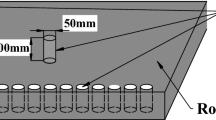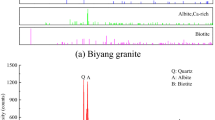Abstract
A persistent increase in the permeability of rock mass caused by transient stress disturbances could explain the variation in groundwater level caused by earthquakes in the far-fields, increase in petroleum production due to artificial vibrations, induction of small earthquakes by seismic waves in intermediate and far-fields, etc. However, the effect of transient stress disturbances on rock permeability has not yet been fully clarified. In this study, the permeability of triaxially fractured Inada granite under multiple transient disturbances in axial stress was measured to clarify the effects of the transient stress disturbances on the fractured rock permeability. In the experiments, the permeability of fractured Inada granite decreased with time. However, the permeability increased with each series of axial stress disturbances whose amplitude was 3 MPa or larger. The degree of increase in permeability increased with the axial stress disturbance amplitudes. The increased permeability decreased with time and the duration in which the permeability decreased to its value before the disturbances was longer for larger axial stress disturbance amplitudes. The increase in permeability could be employed to enhance oil and gas productions, prevent large earthquakes, reroute underground water flow, etc.











Similar content being viewed by others
References
Alam, A. K. M. B., Fujii, Y., Fukuda, D., & Niioka, M. (2014). Temperature-confining pressure coupling effects on the permeability of three rock types under triaxial compression. In R. Alejano, Á. Perucho, C. Olalla, & R. Jiménez (Eds.), Rock Engineering and rock mechanics: Structures in and on rock masses. London: Taylor & Francis Group.
Beresnev, I. A., & Johnson, P. A. (1994). Elastic-wave stimulation of oil production: A review of methods and results. Geophysics, 59(6), 1000–1017.
Beresnev, I. A., Vigil, R. D., Li, W., Pennington, W. D., Turpening, R. M., Iassonov, P. P., et al. (2005). Elastic waves push organic fluids from reservoir rock. Geophysical Research Letters. https://doi.org/10.1029/2005GL023123.
Boeut, S., Oshima, T., Fujii, Y., Kodama, J. I., Fukuda, D., Matsumoto, H., et al. (2019). Variation in the permeability of intact and fractured rocks due to transient disturbances in axial stress or pore pressure. Advances in Civil Engineering, 2019, 16. https://doi.org/10.1155/2019/1312746.
Bower, D., & Heaton, K. (1978). Response of an aquifer near Ottawa to tidal forcing and the Alaskan earthquake of 1964. Canadian Journal of Earth Sciences, 15(3), 331–340.
Brodsky, E. E., Roeloffs, E., Woodcock, D., Gall, I., & Manga, M. (2003). A mechanism for sustained groundwater pressure changes induced by distant earthquakes. Journal of Geophysical Research: Solid Earth, 108(B8), 2390. https://doi.org/10.1029/2002JB002321.
Candela, T., Brodsky, E. E., Marone, C., & Elsworth, D. (2015). Flow rate dictates permeability enhancement during fluid pressure oscillations in laboratory experiments. Journal of Geophysical Research: Solid Earth, 120(4), 2037–2055.
Elkhoury, J. E., Brodsky, E. E., & Agnew, D. C. (2006). Seismic waves increase permeability. Nature, 441(7097), 1135.
Elkhoury, J. E., Niemeijer, A., Brodsky, E. E., & Marone, C. (2011). Laboratory observations of permeability enhancement by fluid pressure oscillation of in situ fractured rock. Journal of Geophysical Research: Solid Earth, 116, B02311. https://doi.org/10.1029/2010JB007759
Engdahl, E. R. (1972). Seismic effects of the MILROW and CANNIKIN nuclear explosions. Bulletin of the Seismological Society of America, 62(6), 1411–1423.
Fujii, Y., Ichihara, Y., Matsumoto, H., Kodama, J. I., Fukuda, D., & Dassanayake, A. B. (2018a). Water drainage from Kushiro Coal Mine decreased on the day of all M ≥ 7.5 earthquakes and increased thereafter. Scientific Report, 8(1), 16472.
Fujii, Y., Sheshpari, M., Kodama, J. I., Fukuda, D., & Dassanayake, A. B. (2018b). Prevention of Catastrophic Volcanic Eruptions, Large Earthquakes underneath Big Cities, and Giant Earthquakes at Subduction Zones. Sustainability, 10(6), 1908.
Gudmundsson, A. (2000). Active fault zones and groundwater flow. Geophysical Research Letters, 27(18), 2993–2996.
Kitagawa, Y., Koizumi, N., Takahashi, M., Matsumoto, N., & Sato, T. (2006). Changes in groundwater levels or pressures associated with the 2004 earthquake off the west coast of northern Sumatra (M9.0). Earth, Planets and Space, 58(2), 173–179.
Lai, G., Jiang, C., Han, L., Sheng, S., & Ma, Y. (2016). Co-seismic water level changes in response to multiple large earthquakes at the LGH well in Sichuan, China. Tectonophysics, 679, 211–217.
Lin, W., & Takahashi, M. (2008). Anisotropy of strength and deformation of Inada granite under uniaxial tension. Chinese Journal of Rock Mech Engineering, 27(12), 2463–2472.
Lin, W., Kwaśniewski, M., Imamura, T., & Matsuki, K. (2006). Determination of three-dimensional in situ stresses from anelastic strain recovery measurement of cores at great depth. Tectonophysics, 426(1–2), 221–238.
Liu, W., & Manga, M. (2009). Changes in permeability caused by dynamic stresses in fractured sandstone. Geophysical Research Letters. https://doi.org/10.1029/2009GL039852.
Manga, M., & Wang, C. (2015). 4.12 Earthquake hydrology. Treatise on Geophysics (2nd ed., pp. 305–328). Oxford: Elsevier.
Manga, M., Beresnev, I., Brodsky, E. E., Elkhoury, J. E., Elsworth, D., Ingebritsen, S., et al. (2012). Changes in permeability caused by transient stresses: Field observations, experiments, and mechanisms. Reviews of Geophysics. https://doi.org/10.1029/2011RG000382.
Matsuki, K., & Takeuchi, K. (1993). Three-dimensional in situ stress determination by anelastic strain recovery of a rock core. In International Journal of Rock Mechanics and Mining Sciences and Geomechanics Abstracts (Vol. 30, pp. 1019–1022). Amsterdam: Elsevier. (Vol. 7).
Oda, M., Takemura, T., & Aoki, T. (2002). Damage growth and permeability change in triaxial compression tests of Inada granite. Mechanics of Materials, 34(6), 313–331.
Orihara, Y., Kamogawa, M., & Nagao, T. (2014). Preseismic changes of the level and temperature of confined groundwater related to the 2011 Tohoku earthquake. Scientific reports, 4, 6907.
Pride, S. R., Flekkøy, E. G., & Aursjø, O. (2008). Seismic stimulation for enhanced oil recovery. Geophysics, 73(5), O23–O35.
Roberts, P. M. (2005). Laboratory observations of altered porous fluid flow behavior in Berea sandstone induced by low-frequency dynamic stress stimulation. Acoustical Physics, 51(1), S140–S148.
Roeloffs, E. A. (1998). Persistent water level changes in a well near Parkfield, California, due to local and distant earthquakes. Journal of Geophysical Research: Solid Earth, 103(B1), 869–889.
Saroglou, C., & Kallimogiannis, V. (2017). Fracturing process and effect of fracturing degree on wave velocity of a crystalline rock. Journal of Rock Mechanics and Geotechnical Engineering, 9(5), 797–806.
Shmonov, V., Vitovtova, V., & Zharikov, A. (1999). Experimental study of seismic oscillation effect on rock permeability under high temperature and pressure. International Journal of Rock Mechanics and Mining Sciences, 36, 405–412.
Wang, C. Y., & Chia, Y. (2008). Mechanism of water level changes during earthquakes: Near field versus intermediate field. Geophysical Research Letters. https://doi.org/10.1029/2008GL034227.
Wang, G., Mitchell, T., Meredith, P., Nara, Y., & Wu, Z. (2016). Influence of gouge thickness and grain size on permeability of macrofractured basalt. Journal of Geophysical Research: Solid Earth, 121(12), 8472–8487.
Xing, Z. G., He, Y., Du, W., & Fang, J. (2018). Review of Research Process and Application of Acoustic Wave Testing Technology for Rock. In IOP Conference Series: Earth and Environmental Science (Vol. 199, p. 052045). Bristol: IOP Publishing. (Vol. 5).
Acknowledgements
This research was supported by the Japan International Corporation Agency (JICA) under the AUN/SEED-Net program (J16-10145).
Author information
Authors and Affiliations
Corresponding author
Ethics declarations
Conflict of interest
The author(s) declare that they have no conflict of intetest.
Additional information
Publisher's Note
Springer Nature remains neutral with regard to jurisdictional claims in published maps and institutional affiliations.
Rights and permissions
About this article
Cite this article
Boeut, S., Fujii, Y., Kodama, JI. et al. Laboratory Investigation on the Permeability Variation of Fractured Inada Granite by Multiple Transient Axial Stress Disturbances. Pure Appl. Geophys. 177, 5385–5396 (2020). https://doi.org/10.1007/s00024-020-02565-2
Received:
Revised:
Accepted:
Published:
Issue Date:
DOI: https://doi.org/10.1007/s00024-020-02565-2




